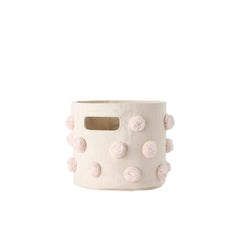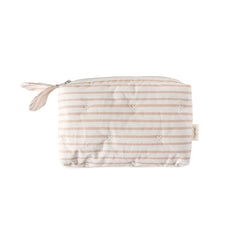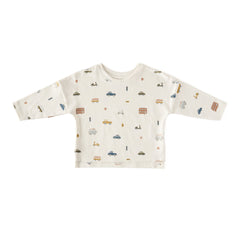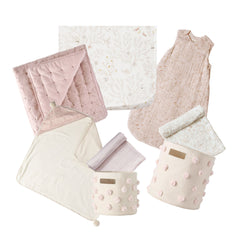Reaching the potty training stage with your little one is an exciting milestone! This is an opportunity for your child to gain independence and confidence and it also means fewer diaper changes for you. From when to start and how to do it, this article will walk you through some of our best potty training tips to help make the transition as smooth as possible for you and your little one.
Table of Contents
- When to start potty training
- How to potty train
- Tips for potty training girls
- Tips for potty training boys
When to start potty training
If you’re wondering when to start potty training, you’re not the only one. This is one of the most commonly asked questions when it comes to toilet training and it’s an important one because starting this process at the right time can make all the difference in the world. So, how do you know if your little one is ready to begin potty training? The first thing you should know is that there is no one specific potty training age that will work for every child. So, don’t get too caught up in what may have worked for your child’s sibling or a friend’s baby. Trying to align yourself with someone else’s timeline won’t necessarily work for you and your little one. The reason for this is, the success of toilet training hinges more on developmental and behavioral milestones than age. Here are a few questions you can ask yourself to help determine whether or not it’s time to start the toilet training process:
- Can my child walk and comfortably sit on a toilet? In order for your child to learn to use the bathroom independently, they’ll, of course, need to be able to get there. So, make sure your little one is steady on their feet before beginning the training process.
- Can your child understand basic instructions? It’s important that you’re able to clearly communicate with your child during the training process. They don’t need to have an extensive vocabulary but they should be able to understand basic instructions. They’ll be relying on you to guide them through this process so communication is key.
- Can your child communicate their basic needs? As your little one gets older you’ll notice that they often become better and better at communicating their needs. This is an important factor in successful toilet training. If your child is able to communicate when they have to go this will make the process a lot easier.
- Is your child excited about it? This might surprise you but most children are pretty excited about potty training. It’s one of the first ‘big kid’ milestones they’ll arrive at and that can be a source of great pride for both you and your little one.
- Is your child starting to dress themselves? Specifically, is your child able to pull on and take off pants and underwear? This is a great stepping stone skill as they’ll need to be able to do this successfully on their own in order to use the bathroom independently. If your little one is already a pro, that’s a great indication that it’s time to begin!
- Is your child’s diaper staying dry for 2-hours or more at a time? This is another great indicator that it’s time to begin the toilet training process.

How to potty train
Now that you know your child is ready to begin the toilet training process, it’s time to learn how to potty train. Here is how we recommend guiding your child through this new and exciting phase of their development.
Set yourself up for success
- Before you dive into the training process, take some time to think about when you want to begin. It’s helpful to select a time when you, your partner, or another caregiver can be at home with your child for a few days in a row. Long weekends are a great option to kick things off. It’s also helpful to pick a time when things are fairly quiet in your household. Avoid having a lot of visitors around or making any other changes to your child’s routine. Have an upcoming vacation? Are the holidays quickly approaching? It’s best to wait until things return to normal before trying to take your child through the toilet training process.
- The more fun you make the process, the smoother it will be. So, make the kick-off an exciting event. Take your little one to the store to pick out some new underwear and pull-up diapers. There are lots of great options with popular characters that will help your child feel excited about trying something new. You can also get them involved in picking their potty as well. Something as simple as selecting a potty in their favorite color or one with a fun pattern they like can make all the difference. Do whatever you can to make sure your child feels confident and eager to take this step forward. If they’re motivated and eager they’ll be much more likely to embrace the training process.
- The final step in getting ready for the toilet training process is explaining it to your little one in terms they can understand. This can be a little tricky with a child’s limited vocabulary. However, children are excellent observers and will often learn by watching others. So, leverage this to help your little one understand the potty training process. If your child has an older sibling, let them observe as they use the toilet. Alternatively, you can use your child’s toys to demonstrate the desired behavior.

Getting started
When you’re ready to dive into the training process here are a few potty training tips to help you nail the first few days:
- On the first day of training, as soon as your child wakes up, remove their diaper and take them to their potty. Usually, they will have to go first thing in the morning so this is a great way to help your child make the association.
- If your child doesn’t go immediately, let them sit on the potty for a few minutes while you read a book together or play with a toy. If your child doesn’t go, don’t scold them. Simply move on and remind them that they can return to the potty to train again later.
- Many parents let their little one spend the first half a day or longer of potty training bare-bottomed. This is because your child may find it easier to recognize the urge to go if they are not wearing diapers or underwear.
- Make sure your child is well hydrated. The more they have to go in the first few days, the more opportunities your little one has to learn about their body’s signals and make the correct associations.
- Ask your child frequently whether they have to go to the bathroom. You may even want to set a reminder on your phone to do this at 20-minute intervals.
- If your little one tells you that they have to go or are showing other tell-tale signs you recognize, take them to the bathroom as quickly as possible.
- When your child successfully uses the potty praise them but be sure to strike the right balance between encouragement and over-excitement. Let your child know they’ve done a good job but don’t make too much of a fuss.
- The same goes for accidents. They are bound to happen and are a natural part of the toilet training process. Don’t shame or scold your child for not making it to the potty on time. Instead, simply remind them that they can head to the bathroom next time they have to urge to go. Additionally, if you’re in the early days of the training process, make sure you have an extra change of clothes when you’re on the go.

Essentials Top - Fountain Blue
Night-time potty training
Some parents choose to do nighttime and daytime training together. While others prefer to help their child get the hang of using the potty during the day first before they focus on nighttime and naps. You can engage your child in this decision-making process if you like to see what they would prefer. Some children are excited about getting out of diapers and will want to try sleeping with underwear right away. Other children might prefer to take it one step at a time. Together, you and your child will find the right process for you!
Tips for potty training girls
- Teaching your little girl how to wipe properly is an important part of the training process. Work on getting your daughter into the habit of wiping from front to back to help her avoid the risk of infection.
- If your little girl has observed an older brother using the bathroom she may try and use the potty standing up. Gently encourage her to try sitting down and she will likely quickly learn that it’s the easiest way to use the bathroom.

Tips for potty training boys
- The most common question parents ask regarding toilet training their boys is whether or not they should be taught to use the potty standing up. Most parents find it easier to start with having their son sit down on the potty. There are a few reasons for this:
- First, bowel movements and urine tend to happen at the same time, especially for young children. So, you’re more likely to have success and avoid accidents if your little one starts by sitting down.
- Second, learning to urinate standing up requires a few extra skills (like figuring out how to aim) and that can be a lot to tackle all at once.






